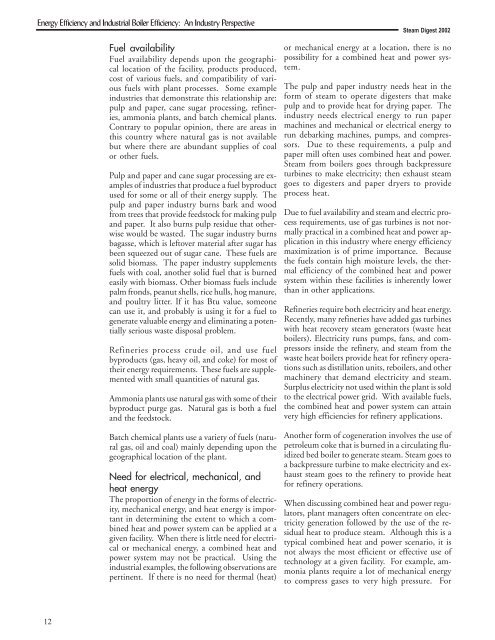Steam Digest 2002 - CiteSeerX
Steam Digest 2002 - CiteSeerX
Steam Digest 2002 - CiteSeerX
Create successful ePaper yourself
Turn your PDF publications into a flip-book with our unique Google optimized e-Paper software.
Energy Efficiency and Industrial Boiler Efficiency: An Industry Perspective<br />
12<br />
Fuel availability<br />
Fuel availability depends upon the geographical<br />
location of the facility, products produced,<br />
cost of various fuels, and compatibility of various<br />
fuels with plant processes. Some example<br />
industries that demonstrate this relationship are:<br />
pulp and paper, cane sugar processing, refineries,<br />
ammonia plants, and batch chemical plants.<br />
Contrary to popular opinion, there are areas in<br />
this country where natural gas is not available<br />
but where there are abundant supplies of coal<br />
or other fuels.<br />
Pulp and paper and cane sugar processing are examples<br />
of industries that produce a fuel byproduct<br />
used for some or all of their energy supply. The<br />
pulp and paper industry burns bark and wood<br />
from trees that provide feedstock for making pulp<br />
and paper. It also burns pulp residue that otherwise<br />
would be wasted. The sugar industry burns<br />
bagasse, which is leftover material after sugar has<br />
been squeezed out of sugar cane. These fuels are<br />
solid biomass. The paper industry supplements<br />
fuels with coal, another solid fuel that is burned<br />
easily with biomass. Other biomass fuels include<br />
palm fronds, peanut shells, rice hulls, hog manure,<br />
and poultry litter. If it has Btu value, someone<br />
can use it, and probably is using it for a fuel to<br />
generate valuable energy and eliminating a potentially<br />
serious waste disposal problem.<br />
Refineries process crude oil, and use fuel<br />
byproducts (gas, heavy oil, and coke) for most of<br />
their energy requirements. These fuels are supplemented<br />
with small quantities of natural gas.<br />
Ammonia plants use natural gas with some of their<br />
byproduct purge gas. Natural gas is both a fuel<br />
and the feedstock.<br />
Batch chemical plants use a variety of fuels (natural<br />
gas, oil and coal) mainly depending upon the<br />
geographical location of the plant.<br />
Need for electrical, mechanical, and<br />
heat energy<br />
The proportion of energy in the forms of electricity,<br />
mechanical energy, and heat energy is important<br />
in determining the extent to which a combined<br />
heat and power system can be applied at a<br />
given facility. When there is little need for electrical<br />
or mechanical energy, a combined heat and<br />
power system may not be practical. Using the<br />
industrial examples, the following observations are<br />
pertinent. If there is no need for thermal (heat)<br />
<strong>Steam</strong> <strong>Digest</strong> <strong>2002</strong><br />
or mechanical energy at a location, there is no<br />
possibility for a combined heat and power system.<br />
The pulp and paper industry needs heat in the<br />
form of steam to operate digesters that make<br />
pulp and to provide heat for drying paper. The<br />
industry needs electrical energy to run paper<br />
machines and mechanical or electrical energy to<br />
run debarking machines, pumps, and compressors.<br />
Due to these requirements, a pulp and<br />
paper mill often uses combined heat and power.<br />
<strong>Steam</strong> from boilers goes through backpressure<br />
turbines to make electricity; then exhaust steam<br />
goes to digesters and paper dryers to provide<br />
process heat.<br />
Due to fuel availability and steam and electric process<br />
requirements, use of gas turbines is not normally<br />
practical in a combined heat and power application<br />
in this industry where energy efficiency<br />
maximization is of prime importance. Because<br />
the fuels contain high moisture levels, the thermal<br />
efficiency of the combined heat and power<br />
system within these facilities is inherently lower<br />
than in other applications.<br />
Refineries require both electricity and heat energy.<br />
Recently, many refineries have added gas turbines<br />
with heat recovery steam generators (waste heat<br />
boilers). Electricity runs pumps, fans, and compressors<br />
inside the refinery, and steam from the<br />
waste heat boilers provide heat for refinery operations<br />
such as distillation units, reboilers, and other<br />
machinery that demand electricity and steam.<br />
Surplus electricity not used within the plant is sold<br />
to the electrical power grid. With available fuels,<br />
the combined heat and power system can attain<br />
very high efficiencies for refinery applications.<br />
Another form of cogeneration involves the use of<br />
petroleum coke that is burned in a circulating fluidized<br />
bed boiler to generate steam. <strong>Steam</strong> goes to<br />
a backpressure turbine to make electricity and exhaust<br />
steam goes to the refinery to provide heat<br />
for refinery operations.<br />
When discussing combined heat and power regulators,<br />
plant managers often concentrate on electricity<br />
generation followed by the use of the residual<br />
heat to produce steam. Although this is a<br />
typical combined heat and power scenario, it is<br />
not always the most efficient or effective use of<br />
technology at a given facility. For example, ammonia<br />
plants require a lot of mechanical energy<br />
to compress gases to very high pressure. For
















